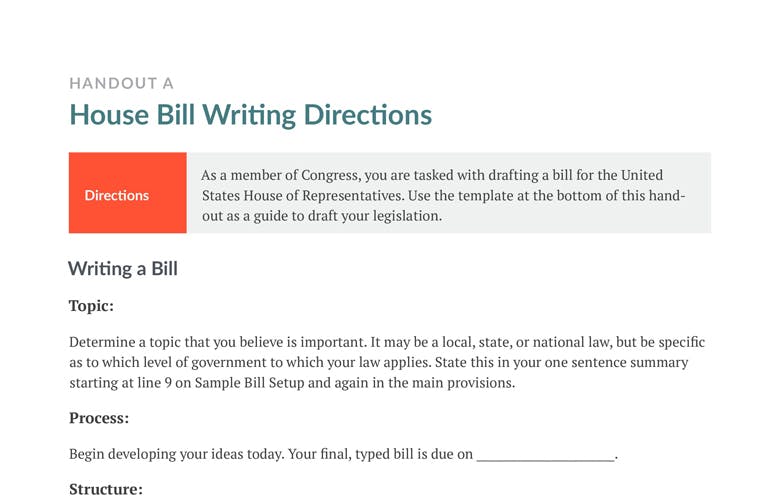Handout A: House Bill Writing Directions
Directions
As a member of Congress, you are tasked with drafting a bill for the United
States House of Representatives. Use the template at the bottom of this handout as a guide to draft your legislation.
Writing a Bill
Topic:
Determine a topic that you believe is important. It may be a local, state, or national law, but be specific as to which level of government to which your law applies. State this in your one sentence summary starting at line 9 on Sample Bill Setup and again in the main provisions.
Process:
Begin developing your ideas today. Your final, typed bill is due on ________________________.
Structure:
- Heading: see sample below.
Follow the structure of the sample bills you were provided on Handouts B and C.- Section 1: Short Title: “This act may be cited as the [title of your bill] act.” Be creative but serious.
- Section 2: Purpose: Explain the goals of your law and what you want to accomplish.
- Section 3: Definitions: Define unusual terms or phrases or those you want to highlight.
- Section 4: Main Provisions: Explain the details of your law and how you will accomplish your goals.
- Section 5: Appropriations:
- How much will it cost?
- Start-up costs
- Continuing annual costs
- Source of money
- Taxes (Raise taxes – by how much)
» Income tax
» Property tax
» Sales tax
» Excise tax (alcohol, tobacco, gasoline, etc.)
If your bill relies on cutting spending to another program, you must explain how you propose to do so. - User Fee (Such as entry fee to a national park, camping fee for a national park, or highway toll)
- Eliminate a program.
- Borrowing (Sell bonds – annual interest expense and source of funds to pay the
interest must be estimated.) - No Private Sources (They are rare and neither continuing nor reliable.)
- Taxes (Raise taxes – by how much)
- If your bill saves money, estimate the initial and annual savings in dollars. Clearly
explain how it saves money with detail. - This is all a best effort guess. Use logic and common sense to estimate costs. You may research for more accuracy.
- How much will it cost?
- Section 6: Penalty Clause (Penalties)
- Encourage compliance
- Punish violators
» Fine – how much?
» Jail time – how long?
» Others
- Section 7: Effective Date
All lines on each bill must be numbered with the first line each page always 1. (See below for first page numbering.)
Sample Bill Set-Up
Your signature here
Student Congress 2016
House Bill No. _________
Creating a law… (one sentence summary)
|
_____________________________ |
introduced the following bill, |
|
(Your typed name) |
|
|
which was introduced to the Committee on |
_____________________ |
|
(Date) |
An Act
- Be it enacted by the Student Congress,…
- Section1: Short Title
-
- Section 2: Purpose
-
-
-
-
-
-
-
-
-
-
